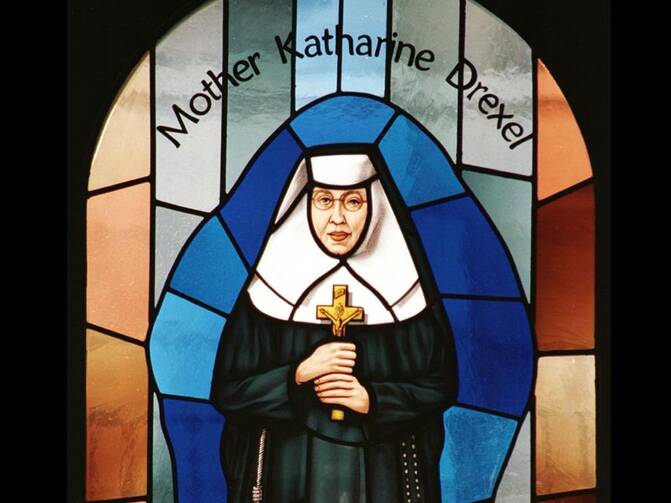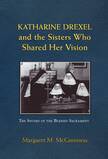Review: St. Katharine Drexel’s complicated record on race
When receiving this book, this reviewer wondered: Why do we need another biography of St. Katharine Drexel? With at least six published volumes on her life, such as Lou Baldwin’s Saint Katharine Drexel (2000), numerous articles on the sisterhood she founded, and even dissertations on the works of her congregation, it would appear that the ground has been well traversed. What more could we learn from yet another study of the long-lived foundress of the Sisters of the Blessed Sacrament for Indians and Colored People—now known as Sisters of the Blessed Sacrament?
Paulist Press
280p $34.95
The historian Margaret McGuinness has performed another valuable service to American Catholic history through her latest book, Katherine Drexel and the Sisters Who Shared Her Vision. In the aftermath of the murder of George Floyd, she and other scholars have begun a timely re-examination of Catholic social and institutional customs involving people of color. Focusing on this complex issue, McGuiness examines one of the most prominent religious orders that served American Blacks and Indigenous peoples. In clear prose and with abundant research, McGuinness reveals how Drexel and her congregation both reflected and challenged American Catholic attitudes toward people of color.
McGuinness integrates a summary of Drexel’s life story with a topical treatment of the ministry of the Sisters of the Blessed Sacrament. Writing neither a full biography of Drexel nor a complete history of the order, McGuinness examines the racial encounters of both within the context of their times.
In the aftermath of the murder of George Floyd, Margaret McGuinness and other scholars have begun a timely re-examination of Catholic social and institutional customs involving people of color.
In 1885, Katharine Drexel (1858-1955) and her two sisters inherited a vast fortune upon the death of their father. Reared in a life of privilege allowing them to engage in Catholic philanthropy, Katharine went further and founded a religious order in 1891 to serve the most neglected in her church, African Americans and Indigenous peoples. Through a lifetime of travels in the South, the West and the Southwest, she witnessed the educational and spiritual neglect of these fellow Catholics.
As “the richest nun in America,” Drexel headed the congregation she founded and also served as a virtual one-woman philanthropic foundation. She directed millions of dollars from her inheritance to construct and staff numerous schools and churches. She also founded Xavier University in New Orleans, the only Catholic institution in the nation dedicated to providing higher education for African Americans. Her sisters served in these institutions and shared her vision of Catholic ministry to those who suffered from segregation and the denial of civil rights. Here is where McGuinness raises a troubling question: Did Drexel and the Sisters of the Blessed Sacrament enable racial segregation by following the policies of Southern bishops who did not integrate Black and white students in Catholic schools?
To begin answering her question, McGuinness titles one subsection “Drexel and Race—It’s Complicated.” Significantly, McGuinness notes that there are few instances where the Sisters of the Blessed Sacrament protested Jim Crow laws in the first half of the 20th century. To do so as white women in the American South, however, would have imperiled their schools and convents. Later, during the civil rights movement, the order was not noted for its participation in that struggle. Most telling, like other women’s religious orders of the times, Drexel’s order did not admit women of color to the community for its first 60 years of existence.
McGuinness cites the rationale of the Sisters of the Blessed Sacrament as documented in the order’s own records. If the sisters accepted women of color into the order, the racist attitudes among the public would make it difficult for the order to raise funds for its works. Further, such racial attitudes would discourage vocations to the Sisters of the Blessed Sacrament because white sisters would object to living in community with sisters who were Black or Native women. Finally, accepting women of color would siphon off vocations from historically Black women’s congregations, such as the Oblate Sisters of Providence and the Sisters of the Holy Family.
McGuinness adds that Drexel and her community chose to work with racial minorities but not to openly challenge the circumstances of the people they served. Rather, Drexel adhered to the gradualist position that John LaFarge, S.J., urged in matters of racial justice.
McGuinness wonders: “What did the SBS know—if they did—and when did they know it?”
As a topical study, McGuinness addresses the issue of race in several sections of her book. She takes a geographic approach through specific chapters on the sisters’ schools in Philadelphia, the American West, the rural South and the urban North, as well as Xavier University in New Orleans. Several themes reappear across these chapters, including Drexel’s vision, generosity and oversight of finances; the previously mentioned reluctance of the Sisters of the Blessed Sacrament to admit women of color to their congregation; and the opportunities that the congregation missed to share leadership and decision making with the people whom they served. There are also examples of the local hierarchy interfering with the work of the sisters.
McGuinness closes her volume with suggestions for further research. Given that the Sisters of the Blessed Sacrament are much reduced in membership, the future of their legacy is in question, such as at Xavier University. Further, rising concern about the deleterious effects on Native children at residential boarding schools already has scholars and others examining the schools run by Drexel’s congregation, such as St. Catherine’s in New Mexico, St. Michael’s in Arizona and St. Paul’s (now the Marty Indian School) in South Dakota. McGuinness wonders: “What did the SBS know—if they did—and when did they know it?” Such matters have gained attention amid the wider clerical sexual abuse scandals in the American Catholic Church.
While Catholic clergy and the church hierarchy are the subjects of lawsuits, the investigations have opened the wider topic of sexual abuse of children and vulnerable adults. McGuinness does not suspect the S.B.S. of harming their charges. Citing the congregation’s archives, to which she was given access, she found no documents related either to accusations of abuse or to lawsuits from the victims. She does caution, however, that historians who examine the wider issue will continue to look at the roles of women religious in the schools and parishes where abuse allegedly occurred.
Should the book be reprinted (and it deserves to be), a future edition would benefit from several additions. Greater attention to the context of the Sisters of the Blessed Sacrament in the discussions of clerical sex abuse and the treatment of residential school children would strengthen the conclusion. Beyond the inclusion of their names, biographical material is needed to bring alive important sisters in the history of the congregation. Finally, an enhanced index that includes an entry for Katharine Drexel would benefit readers seeking access to her as an individual.
McGuinness deserves praise for this study of one sisterhood in the complicated history of race and the American Catholic Church. She documents how Katharine Drexel and the Sisters of the Blessed Sacrament made valiant efforts to combat racism—and did so as women of their times who did not challenge the social hierarchy or protest publically policies they opposed. They may not have imagined integrating their convents, consulting those to whom they ministered or forming coalitions with Black and Indigenous peoples. Such work, however, remains for contemporary Catholics, lay and religious, to embrace and champion.
As we do so, we have the legacy of Drexel and the sisters who shared her vision and took the first steps of a journey that we must continue.
This article also appeared in print, under the headline “Race and Catholic Ministry,” in the January 2024, issue.











